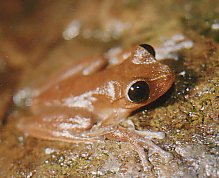Australian lace-lid
| Australian lace-lid | |
|---|---|

| |
| Scientific classification | |
| Kingdom: | Animalia |
| Phylum: | Chordata |
| Class: | Amphibia |
| Order: | Anura |
| Family: | Pelodryadidae |
| Genus: | Ranoidea |
| Species: | R. dayi
|
| Binomial name | |
| Ranoidea dayi (Günther, 1897)
| |

| |
| The range of Nyctimystes dayi. | |
| Synonyms | |
| |
The Australian lace-lid (Ranoidea dayi) is a tree frog endemic to the wet tropics of north-eastern Queensland, Australia.
Description[]
This is a small to medium-sized frog growing up to 50 mm (2.0 in) in length. The dorsal surface is rich-brown to orange-brown with or without scattered cream or lichen-like spots and blotches covering it, the head or the limbs. The arms and legs have faint barring and a slight fringe along the outer edges. The belly is cream-white and granular, with the throat and under surface of the arms and legs being black. The iris is dark brown and the pupil is vertical when constricted. The lower eyelid is patterned with lines, veins, and dots which give the frog its name. Toes are fully webbed and fingers are almost completely webbed. The tympanum is distinct with the upper quarter cover under a skin fold.
Ecology and behaviour[]
This species ranges from Paluma to Cooktown in north Queensland. It is associated with fast-flowing creeks in montane rainforests of altitudes ranging from 0–1,200 m (0–3,937 ft). But can also be found around slower watercourses and rock soaks when ample vegetation is present. They breed from spring to summer with peak breeding occurring from October to April. Males call while on low foliage or rocks close to the stream, and have has two distinct calls. A drawn-out "eeeeeeee" repeated three or four times in concession is made when calling in a group and when calling alone a short "ee" is made every 4–5 seconds. Eggs are large and unpigmented and are laid in clumps of up to 100 attached to submerged objects.
Similar species[]
It may be confused with the fringed tree frog which is readily distinguished by the vertical pupil and the lower eyelid patterning.
Conservation status[]
It is listed as Endangered under both the IUCN Red List and Queensland's Nature Conservation Act 1992.
References[]
- ^ Jean-Marc Hero; ; Michael Cunningham; Keith McDonald; Richard Retallick (2004). "Litoria dayi". The IUCN Red List of Threatened Species. IUCN. 2004: e.T14969A4484777. doi:10.2305/IUCN.UK.2004.RLTS.T14969A4484777.en. Retrieved 10 January 2018.
Additional sources[]
- Department of Environment and Heritage - Lace-eyed Tree Frog
- Frogs Australia Network - call available here
- Barker, J.; Grigg, G.C.; Tyler,M.J. (1995). A Field Guide to Australian Frogs. Surrey Beatty & Sons.
- IUCN Red List endangered species
- Amphibians of Queensland
- Endangered fauna of Australia
- Nature Conservation Act endangered biota
- Ranoidea (genus)
- Amphibians described in 1897
- Taxa named by Albert Günther
- Frogs of Australia
